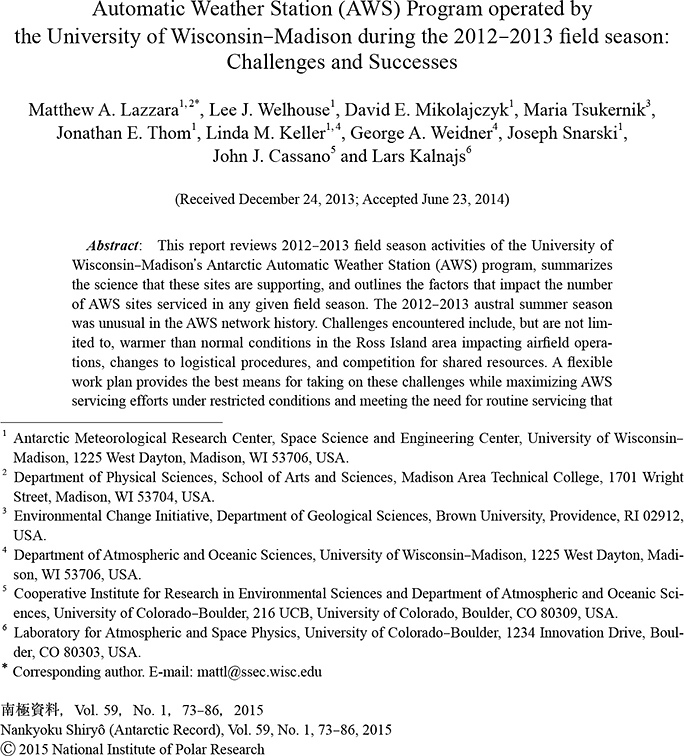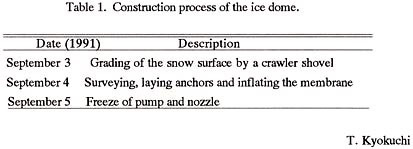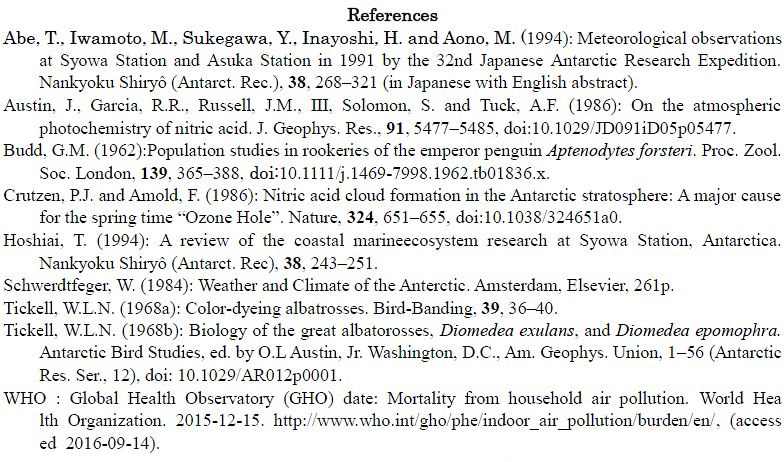Submission guide for Antarctic Record
I. Submission requirements
- 1.
-
This journal is primarily for rapid publication of observations by the Japanese Antarctic Research Expedition, findings from research using data and samples obtained from the Japanese Antarctic Research Project, and findings from research relating to the Japanese Antarctic Research Project. It also publishes scientific research findings and official reports relating to the polar regions in general, including the Arctic. We welcome contributions not just from researchers but also from technologists involved in polar science or the Japanese Antarctic Research Expedition.
- 2.
-
There are four types of submission. When submitting a manuscript, please designate one of these types.
a. Scientific paper
Research findings that are likely to contribute to the advance of polar science.b. Scientific note
Preliminary research reports, new ideas, proposals, questions, case studies, etc. that are deemed worthy of being placed on record.c. Review article
Summary of previous studies and discussion of trends in research on a particular topic in polar science.d. Report
Selected reports on observations of the Japanese Antarctic Research Expedition, reports on the Japanese Antarctic Research Project and research projects in the Arctic, and reports on symposiums and meetings concerned with polar science that are deemed worthy of being placed on record. - 3.
-
The submitting author(s) should submit a manuscript prepared in accordance with the submission guidelines to the office of the editorial committee through the online submission system. The date of receipt is the date that the submission is completed.
- 4.
-
When the submission is received, the author may be offered advice and guidance on the paper type, paper structure, problems with language, etc. by the editorial committee, which includes researchers in various fields of study (space and upper atmospheric sciences, meteorology and glaciology, geoscience, bioscience, and polar engineering). Acceptance or rejection of manuscripts for publication and the order of publication are decided by the editorial committee.
- 5.
-
After the submission is received, it is peer-reviewed and proofread by two referees in the case of a scientific paper, scientific note, or review article, or by one referee in the case of a report. Authors can recommend candidates for referees through the online submission system. After the peer review, a final manuscript revised according to the peer review and proofreading should be resubmitted to the office through the online submission system.
- 6.
-
The author is responsible for checking the first proof. Subsequent checks and copyediting will be carried out by the journal office. If it is known beforehand that the author will not be available, measures should be taken to avoid a delay in proofreading.
- 7.
-
The copyright of published papers etc. belongs to our Institutions: Research Organization of Information and Systems, National Institute of Polar research.
- 8.
-
Papers will be published with open access.
Ref: Open access https://www.budapestopenaccessinitiative.org/
II. Submission guidelines (style guide)
- 1.
-
The language of a paper must be either Japanese or English.
- 2.
-
A scientific note should be no more than 15 pages including the abstracts, figures, references, etc. (and no more than 10 pages of text). Other types of manuscript are not particularly limited in length but should be written as concisely as possible without sacrificing clarity.
- 3.
-
For either Japanese or English manuscripts, the text should run left-to-right and be double-spaced on A4-size pages with approximately 3-cm top and bottom margins and approximately 2.5-cm left and right margins. Japanese should be 40 characters per line, using modern orthography and standard kanji. English text should not be fully justified.
- 4.
-
The title of the paper should concisely and clearly indicate the content of the paper. If the title is more than 30 characters for a Japanese paper or more than 50 characters (including spaces) for an English paper, a running title (a short title to be shown in the header of each page) must be specified.
- 5.
-
The authors shall avoid conflicts of interest and describe on a separate sheet (Word) concerning any financial interests or personal relationships that may influence the submission.
- 6.
-
Authorship is based on the following two criteria; substantial contribution to the research or writing of the paper, and final approval and accountability for the accepted manuscript. If a deceased person is to be listed as an author considering his/her contribution, all co-authors must guarantee the deceased’s contribution and conflict of interest with an application form (Word). When applying, a permission from the heirs to add the deceased as an author is required. Add a dagger symbol after his/her name, along with a footnote stating 'Deceased'. It is not acceptable to name the deceased as the corresponding author. If the author becomes deceased after the submission and before the publication of the paper, please contact the editorial office and correct the description.
- 7.
-
The surnames and given names of authors must be written in full.
- 8.
-
The title, author name(s) and affiliated institution(s) must be written on a separate sheet from the main text. The title and each author name should be written in the middle of the page and the affiliated institution should be put in a footnote. If the author has retired from the listed affiliation, add asterisk ** and a footnote stating that he/she is currently retired. After the English name of each author’s affiliated institution, include a physical address and postal code. The country name of Japan does not need to be included in the address.
- 9.
-
As a general rule, the length of the abstract should be no more than 200 words in English and no more than 400 characters in Japanese. When the paper is in Japanese, a Japanese abstract and an English abstract must be attached. When the paper is in English, only an English abstract must be attached.

- 10.
-
Whether the paper is in Japanese or English, specify at least one appropriate keyword.
- 11.
-
Unless the paper is particularly short, divide it into sections with headings numbered in the style "1.", "2.", etc. Long sections should be further divided into subsections, with headings numbered in the style "1.1.", "1.2.", etc.
- 12.
-
Use Arabic numerals. As a general rule, units should be SI units (Système international d'unités).
- 13.
-
Equations should be formatted as illustrated in the following examples. Each equation should be written on a line of its own, separated from the main text by two or three lines. As a general rule, a comma or period should be placed at the end of each equation. Where an equation is mentioned in the text, use the style "eq. (1)" in English.

- 14.
-
For Antarctic place names, use the names listed in the references below:
1)Gazetteer of eastern Dronning Maud Land, Antarctica, comp. by K. Moriwaki. 1st ed. Tokyo, Natl. Inst. Polar Res., 225 p., 2000 (with errata 2002)
2)Composite Gazetteer of Antarctica, hosted by the Australian Antarctic Data Centre.
https://data.aad.gov.au/aadc/gaz/scar/ - 15.
-
Tables should be prepared in a separate file, using one page for each table. The page size should be the same as for the text (A4 size), with 3-cm or wider top and bottom margins and 2.5-cm or wider left and right margins. Put a sequential number (Table 1, Table 2, etc.) and the author name(s) at the bottom right of the page. In a Japanese paper, provide captions in both Japanese and English. In an English paper, provide captions in English. The captions should be provided in a separate file called "Table captions".

- 16.
-
Figures must have captions. In a Japanese paper, provide captions in both Japanese and English. In an English paper, provide captions in English. The captions should be provided in a separate file called "Figure captions". Give every figure, including photographs, a sequential number (Fig. 1, Fig. 2, etc.). Put the figure number together with the author name(s) at the bottom right of the figure. Photographs should be treated in the same manner as other figures.
- 17.
-
If the author wishes a figure (including photographs) to be reduced in size, make this request in advance. The editorial committee will make the final decision.
- 18.
-
Where tables and figures (including photographs) are mentioned in the text, use the style "Table 1", "Fig. 1", etc.). Apply right-justification to lines in the text manuscript where tables and figures will be inserted.
- 19.
-
Avoid the use of footnotes as much as possible. When a footnote must be used, refer to it with an asterisk (*). Put the footnote below a horizontal line at the bottom of the same page, with the word "Footnote" in red text.
- 20.
-
References should be listed at the end of the text and formatted as in the examples provided below. References with one or two authors should be arranged in alphabetical order of the author names as shown below. Multiple references by the same author and references with three or more authors should be arranged in order of publication year. References with the same publication year should be distinguished by appending a lower case letter a, b, etc. after the year, and arranged in order as shown below.
Reference to an article in a journal
Author(s) (year): Title of paper. Journal title, volume number (issue number only if page numbering restarts in each issue), first page–last page, DOI.Reference to a whole book
Author(s) (year): book title. Edition. Place of publication, publisher, total number of pages (series title if applicable), DOI.Reference to a chapter or part of a book
Author(s) (year): Title of chapter or section. Book title, editor. Edition. Place of publication, publisher, first page–last page (series title if applicable), DOI.Reference to a website or webpage
Author(s): webpage title. Name of website. Date updated, access address, (access date).
- 21.
-
Where a reference is mentioned in the text, use the following styles: For one or two authors "Budd (1962)", "Miyamoto (1990)" or "(Griffiths and King, 1965; Tickell, 1968a, b)", etc. For three or more authors, "Delmas et al. (1982)", or " (Delmas et al., 1982; Abe et al., 1993) ".
- 22.
-
Do not use the Cyrillic alphabet for Russian language references. Use an English translation and mark it "(in Russian)." In the text, if no English translation is available, transliterate Russian to the Latin alphabet.

- 23.
-
In an English paper, citations of a Japanese paper should be translated to English and marked "(in Japanese)" or "(in Japanese with English abstract)." In the main text, if no English translation is available, transliterate Japanese to the Latin alphabet.
- 24.
-
When a Japanese language journal is cited in an English paper, the journal title should generally be transliterated to the Latin alphabet. If there is an English title, it may be included in parentheses after the transliterated Japanese title.

- 25.
-
For abbreviations of journal titles, see the most recent editions of World List of Scientific Periodicals, London, Butterworths and Bibliographic Guide for Editors and Authors, Washington, D.C., American Chemical Society, as recommended by the International Organization for Standardization (ISO). If no abbreviation can be found, do not make up an abbreviation; write the name in full.
- 26.
-
Avoid citations of unpublished papers. If such a citation is necessary, mark it in the text with "private communication" or "personal communication".
- 27.
-
A citation of a paper currently under submission to a journal should be marked "in press" if publication has been approved. Give the page number if the paper is in proof and the page number is known. Avoid citations of articles for which publication is not yet confirmed. If such a citation is necessary, mark it "submitted to".
- 28.
-
When you register and publish data or software used in the paper, place it in a reliable repository which provides a persistent identifier (such as a DOI), free access, and liberal copyright. And be sure to write the URL which directly lands to your data/software.

